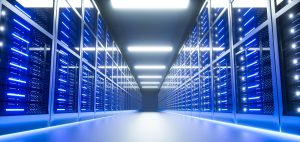The Changing Role of the Data Center
Historically, data centers were physical rooms filled with servers, networking equipment, and cooling systems, which were primarily managed on-site. However, the rapid adoption of cloud computing has led to the emergence of virtual data centers (VDCs), which provide greater flexibility, scalability, and efficiency. According to a 2024 report by Gartner, 75% of enterprise-generated data will be processed outside of traditional data centers by 2026, as organizations increasingly shift toward edge computing and hybrid cloud solutions.
Cloud platforms such as Amazon Web Services (AWS), Microsoft Azure, and Google Cloud offer businesses the ability to scale workloads dynamically, reducing dependency on on-premises infrastructure. However, many enterprises are opting for hybrid models, where mission-critical workloads remain on-premises while less sensitive applications migrate to the cloud. This approach optimizes performance and security while lowering operational costs.
Emphasis on Building Design and Energy Efficiency
As data centers grow in size and complexity, the focus on sustainable design and energy management has intensified. Modern data center design now prioritizes energy efficiency, using innovative cooling technologies, renewable energy sources, and advanced power management systems. According to a 2024 report by the International Energy Agency (IEA), global data center electricity consumption is projected to increase by 50% by 2030, primarily driven by the growing demand for AI and high-performance computing.
To mitigate environmental impact, data center operators are investing in energy-efficient technologies, such as liquid cooling systems, which dissipate heat more effectively than traditional air cooling systems. Additionally, many data centers are adopting renewable energy sources, with hyperscale operators like Google and Microsoft pledging to run on 100% renewable energy by 2030.
Integration of AI and Facility Management
Artificial intelligence is playing an increasingly critical role in optimizing data center operations. AI-powered systems monitor power usage, cooling, and workload distribution, ensuring that resources are allocated efficiently. A study by Uptime Institute highlights that AI can reduce data center operational costs by up to 30% through predictive maintenance and workload optimization.
Facility management has also become more complex as data centers expand in scale. Operators are using smart building technologies to monitor environmental conditions, security protocols, and asset performance. These advancements ensure that data centers operate at peak efficiency while maintaining uptime and minimizing operational risks.
Sustainability as a Core Objective
Sustainability is no longer an afterthought but a primary goal for data center operators. With growing regulatory pressures and increased environmental awareness, data centers are focusing on minimizing their carbon footprint. The adoption of modular data center designs, which enable incremental expansion and improved energy efficiency, is gaining momentum. Additionally, advances in software-defined data centers (SDDCs) are enabling intelligent resource allocation and workload management, further contributing to sustainability goals.
Challenges and Future Considerations
Despite these advancements, the transformation of data centers presents challenges. Security remains a top concern in hybrid environments, where sensitive data is spread across on-premises and cloud platforms. Furthermore, the integration of emerging technologies such as quantum computing and AI presents new complexities for data center management.
To address these challenges, industry experts emphasize the importance of robust security protocols, compliance with international standards, and continuous investment in workforce training. As the demand for low-latency, high-performance applications increases, data centers will need to adapt rapidly to meet these evolving requirements.
A Sustainable, Hybrid Future
The evolution of data centers reflects a broader trend toward digital transformation and sustainable infrastructure. As enterprises adopt hybrid and multi-cloud environments, they must strike a balance between performance, security, and sustainability. The integration of AI, energy-efficient designs, and intelligent facility management is paving the way for the data center of the future—a virtual ecosystem capable of supporting the next generation of technological advancements.



